Imagine the thrill of sitting in an open jeep, the cool morning breeze brushing your face, when suddenly the jungle falls silent. A flock of birds takes off, the spotted deer freeze, and your naturalist whispers—“Tiger!” Moments like this are what make a safari at Jim Corbett National Park so unforgettable.
Tucked away in the Himalayan foothills of Uttarakhand, Jim Corbett is not just any national park. It’s India’s very first national park (established in 1936) and the birthplace of Project Tiger—India’s most successful tiger conservation effort. For wildlife lovers, photographers, families, and even first-time safari-goers, Corbett offers an adventure that blends raw wilderness with history.
If you’re planning a trip, this guide will walk you through everything you need to know about a Corbett safari—from the best zones and timings to costs, accommodation, and tips for spotting the elusive Bengal tiger.
Why Choose Safari at Jim Corbett National Park?
There are dozens of wildlife sanctuaries in India, but Corbett stands apart for a few reasons:
-
Tiger Country: With one of the highest densities of Bengal tigers in India, your chances of spotting one are fairly high.
-
Diverse Wildlife: Leopards, wild elephants, sloth bears, gharials, deer, and more than 650 species of birds call this park home.
-
Scenic Landscape: A mix of hills, rivers, grasslands, and dense sal forests makes every safari ride feel like a postcard.
-
Accessibility: Just six hours from Delhi, Corbett is one of the easiest parks to reach for both Indian and international travelers.
-
Legacy of Jim Corbett: Named after the legendary hunter turned conservationist, the park has a fascinating history that adds depth to every safari.
Safari Zones: Where Should You Go?
Jim Corbett isn’t one big safari track—it’s divided into six different zones, and each one offers a different flavor of the wild:
Dhikala Zone
The crown jewel of Corbett. If you dream of tigers and wild elephants, this is the place. Overnight stays inside the forest rest houses here are a bucket-list experience.
Bijrani Zone
Known for its beautiful mix of grasslands and forests, and very popular for tiger sightings.
Jhirna Zone
Open year-round, it’s excellent for birdwatching and spotting sloth bears.
Dhela Zone
Rich in flora and fauna, this zone is still relatively quiet and less crowded.
Durga Devi Zone
A birdwatcher’s paradise, with mahseer fish in the Ramganga River and stunning forest landscapes.
Sitabani Buffer Zone
While not a core tiger area, it’s great for nature walks, temples, and peaceful safaris.
read more : Unique Experiences Every Foreigner Should Have in India
Types of Safaris at Jim Corbett
Jeep Safari
The most popular choice. A jeep takes 6 people and can enter multiple zones.
Canter Safari
A bigger, bus-like open vehicle (16–20 people), available mostly in Dhikala.
Birdwatching Safari
Customized trips for birding enthusiasts.
Elephant Safari (very limited now)
Offered only in select buffer areas.
Book your safari permits well in advance on the official Uttarakhand Forest Department website. They sell out quickly, especially for popular zones.
Best Time to Visit Jim Corbett
Corbett offers a different experience in every season:
- Winter (Nov–Feb): Cool, crisp weather and excellent chances of spotting tigers.
- Summer (Mar–June): Hot, but animals gather around water bodies, making sightings easier.
- Monsoon (July–Sept): Most zones are closed due to rain, except Jhirna and Sitabani.
Best months for tiger safaris: November to April.
How to Reach
- By Air: Pantnagar Airport is the closest (80 km), but Delhi Airport (260 km) has better connectivity.
- By Train: Ramnagar Railway Station, just 12 km away, is well-connected to Delhi and other cities.
- By Road: A scenic 6-hour drive from Delhi; 3 hours from Nainital.
Where to Stay
- Forest Rest Houses: Simple, government-run stays inside the park (especially Dhikala). The real jungle experience.
- Luxury Resorts: Properties like Aahana, Taj Corbett, and Jim’s Jungle Retreat offer five-star comfort with jungle vibes.
- Budget Stays: Guesthouses and lodges near Ramnagar suit backpackers and families.
Wildlife You Can Spot
- Big Cats: Tigers, leopards, jungle cats.
- Elephants: Majestic herds often cross safari tracks, especially in Dhikala.
- Birds: From crested serpent eagles to colorful kingfishers, birders will be in paradise.
- Reptiles: Crocodiles, gharials, and the occasional python.
- Other Mammals: Sambar deer, wild boars, jackals, and sloth bears.
Safari Costs
- Jeep Safari: ₹4,500–₹6,000 per jeep (up to 6 people).
- Canter Safari: ₹1,500–₹2,500 per person.
- Forest Rest House Stays: From ₹2,000 per night (basic facilities).
Quick Safari Tips
- Carry a valid photo ID (same as used for booking).
- Morning safaris usually offer the best chances of spotting wildlife.
- Dress in earthy colors—avoid bright clothes.
- Always maintain silence and follow the guide’s instructions.
- Respect the jungle: don’t litter, don’t feed animals, and avoid loud noises.
Common Questions Travelers Ask (FAQs)
Q1. Which zone is best for first-time visitors?
Dhikala or Bijrani. Both have great tiger sighting records.
Q2. How far in advance should I book?
At least 30–45 days in advance, especially for popular zones.
Q3. Are children allowed?
Yes, children above 5 years can join jeep safaris.
Q4. Can foreigners book safaris easily?
Absolutely. Just carry your passport as ID proof.
Q5. How many days are enough for Jim Corbett?
A 2–3 day trip with 2–3 safaris is ideal.
Final Thoughts
A safari at Jim Corbett National Park is more than just a holiday—it’s a chance to reconnect with nature, witness India’s incredible wildlife, and maybe even lock eyes with the magnificent Bengal tiger. Whether you’re a seasoned wildlife traveler or planning your very first jungle adventure, Corbett promises experiences that stay with you for a lifetime.
So pack your binoculars, charge your camera, and get ready—because the jungle is calling.




